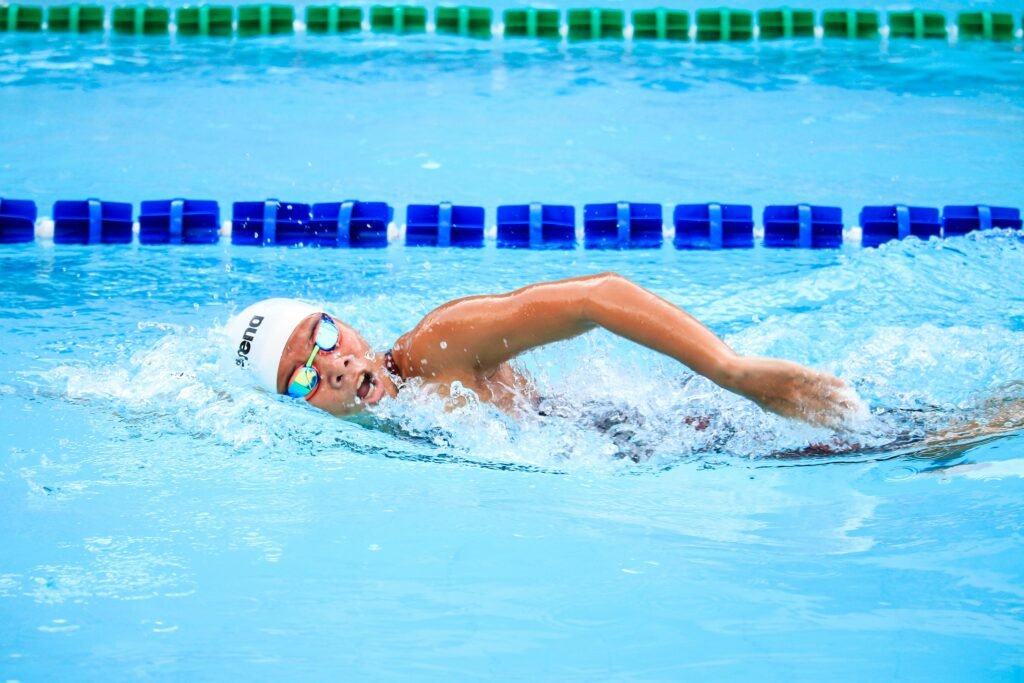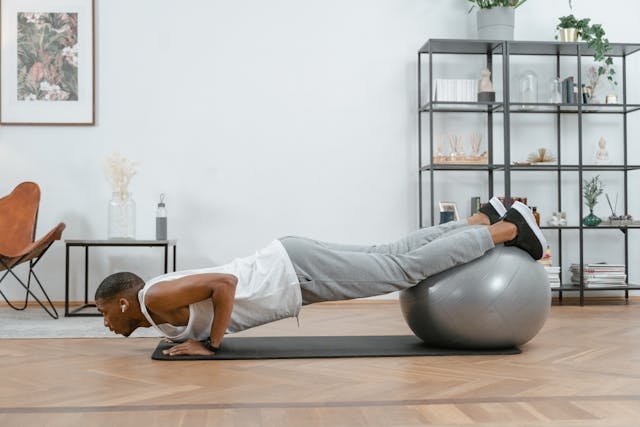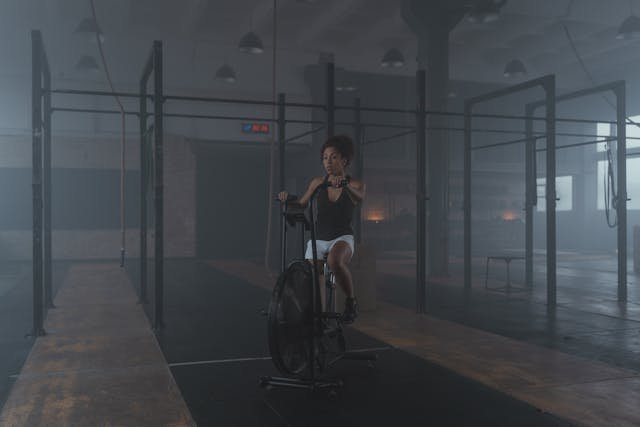Radiofrequency ablation (RFA) is a minimally invasive procedure that uses heat generated by radiofrequency energy to target and reduce nerve pain. After undergoing RFA, it’s common to wonder when and how to resume exercise.
Starting exercise too soon or choosing the wrong type could hinder recovery, but with the right approach, exercise can actually aid the healing process. Here’s a comprehensive guide to safe exercises and the benefits of staying active after RFA.
Key Takeaway:
- Start slowly with low-impact activities like walking or swimming to ease back into exercise.
- Focus on gentle core strengthening and flexibility exercises, such as Pilates or yoga.
- Avoid high-impact activities (e.g., running, heavy lifting) that could strain the treated area.
- Listen to your body and stop any exercise that causes discomfort.
- Consult your doctor before beginning any new exercise routine to ensure safe recovery.
Table of Contents
1. Swimming

Swimming is an excellent low-impact activity post-RFA. This water-based exercise minimizes strain on joints while working muscles efficiently. Wait until your doctor approves, as immersion in water too soon could increase the risk of infection if the treatment area hasn’t fully healed.
For more information, check here and here.
2. Walking

Walking is one of the easiest and safest exercises, and you can start soon after RFA. It promotes blood flow, aids in reducing stiffness, and gradually rebuild endurance without putting too much pressure on the treated area. Start with short, slow walks and increase your pace and distance over time as tolerated.
For more details, check here and here.
3. Core Strengthening

Core strengthening can help support the spine and alleviate pressure on areas affected by chronic pain. After RFA, focus on gentle exercises like pelvic tilts or modified planks. Avoid exercises that strain the lower back until you’re further along in recovery, and always prioritize form over intensity.
For more information about the benefits of core strengthening post-RFA, check here and here.
4. Stretching

Gentle stretching can help relieve tension and improve flexibility post-RFA. Start with light stretches that target the muscles surrounding the treated area, such as hamstring and lower back stretches. Avoid aggressive stretching that could strain sensitive areas. Stretching can be especially helpful in preventing muscle stiffness as you recover.
For more details about the impact of stretching post-RFA, check here.
Related: How to Shrink a Goiter Naturally
5. Yoga

Yoga offers a blend of stretching, strength, and mindfulness that can aid recovery after RFA. Focus on gentle yoga poses, such as child’s pose or cat-cow stretches, which promote flexibility and relaxation without placing excessive strain on the treated area. Avoid intense or twisting poses initially, and listen to your body’s response.
For more information about yoga, check here.
Related: What Should TSH Levels Be After Thyroid Cancer?
6. Resistance Training

Light resistance training, such as using resistance bands or light dumbbells, can help rebuild strength without straining the body. Focus on exercises targeting upper body muscles or areas away from the treated site. As you progress, you can gradually increase weights and reps, but keep intensity low initially.
For more information, check here and here.
7. Stationary Bike

Using a stationary bike is a great way to get in some low-impact cardio post-RFA. Unlike traditional cycling, stationary biking allows you to control resistance and intensity levels, making it a safer choice during early recovery. Start at a low resistance setting and listen to your body’s response.
For more details, check here.
8. Cycling

Outdoor cycling can be beneficial once you’ve built some endurance with stationary biking and received medical clearance. Keep to flat terrains initially and avoid high speeds or difficult terrain that may stress the treated area. This gradual progression helps to improve leg strength and cardiovascular health.
For more information about the benefits of cycling post-RFA, check here.
9. Pilates

Pilates focuses on core strength and stability, making it suitable for post-RFA recovery. Start with beginner movements, like pelvic tilts and bridges, to strengthen your core gently. Avoid exercises that involve sudden movements or high-intensity core work until you’ve fully regained strength and stability.
For more information, check here.
The Benefits of Exercising After RFA
Exercising after RFA can offer several benefits that support your recovery and improve long-term well-being:
- Enhanced flexibility: Exercise improves muscle flexibility, reducing the risk of stiffness and aiding in recovery.
- Pain management: Gentle movement can stimulate the release of endorphins, the body’s natural painkillers, and improve circulation.
- Strengthened muscles: Exercise helps rebuild strength in muscles that may have weakened due to chronic pain or inactivity.
- Improved mental well-being: Physical activity releases mood-boosting chemicals, supporting mental health during recovery.
Activities You Should Avoid After Radiofrequency Ablation
Some exercises and activities should be avoided immediately after RFA to prevent strain or injury to the treated area:
- High-impact exercises: Avoid running or intense aerobic workouts that can put unnecessary pressure on the affected area.
- Heavy lifting: Lifting heavy weights can strain muscles around the treatment area and increase the risk of injury.
- Contact sports: Sports like football or basketball involve intense physical contact, which can jeopardize healing post-RFA.
- Twisting exercises: Avoid activities like certain forms of intense yoga, which can place stress on the treated area.
Precautions When Exercising After RFA
When resuming exercise, consider these precautions to ensure a safe recovery:
- Listen to your body: Avoid pushing through pain and take breaks as needed.
- Start slow: Begin with low-impact exercises and increase intensity gradually as your body allows.
- Stay hydrated: Proper hydration helps keep your muscles flexible and aids in recovery.
- Follow medical advice: Always consult your healthcare provider before resuming any exercise routine.
Related:
FAQs: How Long After RFA Can I Exercise?
Typically, you should wait at least 1 to 2 weeks before starting light exercise after radiofrequency ablation (RFA), depending on your doctor’s guidance. Start with low-impact activities and gradually increase intensity if there’s no pain or discomfort.
What is the Best Exercise After an Ablation?
The best exercise post-RFA is walking, as it is gentle, low-impact, and promotes circulation without putting pressure on the treated area. Other good choices include swimming and gentle stretching once your doctor approves.
What Can You Not Do After Radiofrequency Ablation?
Avoid:
- High-impact exercises like running or intense aerobics.
- Heavy lifting could strain the treated area.
- Contact sports that risk jolts or injuries, such as football or basketball.
- Twisting movements, such as in certain yoga poses, that can stress the spine or affect nerves.
Can I Exercise After RF Treatment?
Yes, you can exercise after RF treatment, but it’s important to start with gentle, low-impact activities. High-intensity workouts should be postponed until you’ve fully healed, typically several weeks after RFA.
How Long Does It Take for Nerves to Grow Back After Ablation?
It usually takes 6 to 12 months for nerves to begin regrowing after RFA. In some cases, it can take even longer. Pain relief often lasts until nerves regenerate, but additional ablation sessions may be needed if pain returns.
When Can I Start Walking After Ablation?
Walking is generally safe to resume within a few days to a week after RFA. However, start with short, slow walks and gradually increase your pace and duration as tolerated.
What Foods to Avoid After Ablation?
After ablation, it’s best to avoid foods that can increase inflammation, such as:
- Sugary foods (e.g., soda, candy)
- Processed foods high in preservatives
- Fried foods and foods high in unhealthy fats
- Alcohol, which can interfere with recovery
Opt instead for anti-inflammatory foods, like fruits, vegetables, lean proteins, and whole grains, to support healing.
Radiofrequency Ablation Uses
Radiofrequency ablation (RFA) is a versatile procedure widely used in the treatment of various medical conditions. One of its primary uses is in managing chronic pain, particularly in the neck, back, and joints, by targeting and disrupting specific nerves that transmit pain signals. In cardiology, RFA is a highly effective treatment for arrhythmias, such as atrial fibrillation, as it disrupts abnormal electrical pathways in the heart. It is also utilized in oncology to destroy tumors in organs like the liver, kidneys, or lungs. Additionally, in the field of cosmetic medicine, RFA is popular for skin tightening and wrinkle reduction, showcasing its broad applications across multiple specialties.
Radiofrequency Ablation Cost
The cost of radiofrequency ablation depends on factors like location, procedure type, and insurance coverage. In the United States, the average cost ranges from $2,000 to $7,000 per session. Insurance often covers RFA if it’s deemed medically necessary, such as for chronic pain or arrhythmias.
However, patients should confirm coverage with their provider to avoid unexpected expenses. Additional costs, such as consultations, imaging studies, and follow-up appointments, may also contribute to the total expense.
Radiofrequency Ablation Side Effects
While radiofrequency ablation is considered safe, it can result in side effects. Common radiofrequency ablation side effects include mild pain, swelling, bruising, and temporary numbness around the treated area, which usually resolve within a few days to weeks.
Rare but more serious complications may include infection, nerve damage, or skin burns. For tumor ablation, there is a slight risk of injury to surrounding organs.
Patients should follow their doctor’s aftercare instructions to minimize risks and contact their healthcare provider if they experience prolonged pain, signs of infection, or severe numbness.
Neuritis After Radiofrequency Ablation Treatment
Neuritis, or nerve inflammation, can occur when nearby nerves are irritated during the RFA procedure. This condition may cause symptoms such as sharp, burning pain or heightened sensitivity in the affected area. While uncomfortable, neuritis is usually temporary and can be managed with anti-inflammatory medications, physical therapy, or nerve blocks to alleviate pain and reduce inflammation.
Worse Pain After Radiofrequency Ablation
Experiencing worse pain after radiofrequency ablation is not uncommon and is often due to temporary nerve irritation or tissue healing. This pain flare-up typically subsides within a few weeks as the body adjusts. However, severe or prolonged pain may indicate complications such as neuritis, nerve injury, or improper nerve targeting. Over-the-counter pain relievers, anti-inflammatory medications, or physical therapy can help manage the discomfort. Patients should seek medical advice if the pain persists beyond the expected recovery period.
Massage After Radiofrequency Ablation
Massage can be beneficial for relieving muscle tension and soreness after RFA. However, it is crucial to avoid direct pressure on the treated area for at least 1–2 weeks to prevent irritation or complications. Gentle massages on surrounding muscles may help with stiffness or discomfort. Before resuming massage therapy, consult your doctor to ensure it is safe based on your treatment and recovery progress.
Leg Numbness After Radiofrequency Ablation
Leg numbness can occur after radiofrequency ablation if the procedure impacts nearby sensory nerves. This side effect is typically temporary and resolves within a few weeks as the nerves heal.
Persistent or severe numbness, however, may indicate nerve damage and should be evaluated by a doctor. Physical therapy and medications may be recommended to address lingering symptoms and promote recovery.
How to Sleep After Radiofrequency Ablation
Sleeping comfortably after radiofrequency ablation can be challenging, particularly if the treated area is painful or sensitive. To minimize discomfort, choose a sleeping position that avoids putting pressure on the treated area.
Using supportive pillows to elevate certain parts of the body, like the neck or legs, can help reduce swelling and promote healing. Additionally, avoid strenuous activities or movements before bedtime to ensure a restful and comfortable sleep.
Conclusion
Exercise after radiofrequency ablation can be a valuable part of your recovery process, offering numerous physical and mental benefits. By starting with gentle, low-impact exercises and gradually increasing intensity, you can safely rebuild strength and flexibility.
Always consult your doctor before resuming activity to ensure you’re choosing exercises that align with your recovery plan. With the right approach, exercise can support both your healing and overall quality of life.
Reference
- Joh JH, Kim WS, Jung IM, Park KH, Lee T, Kang JM; Consensus Working Group. Consensus for the Treatment of Varicose Vein with Radiofrequency Ablation. Vasc Specialist Int. 2014 Dec;30(4):105-12. doi: 10.5758/vsi.2014.30.4.105. Epub 2014 Dec 31. PMID: 26217628; PMCID: PMC4480318.
- Wray JK, Dixon B, Przkora R. Radiofrequency Ablation. [Updated 2023 Jun 12]. In: StatPearls [Internet]. Treasure Island (FL): StatPearls Publishing; 2024 Jan-. Available from: Available here
- Back SH, Kowey PR. Strategies to Reduce Recurrent Shocks Due to Ventricular Arrhythmias in Patients with an Implanted Cardioverter-Defibrillator. Arrhythm Electrophysiol Rev. 2019 May;8(2):99-104. [PMC free article] [PubMed]2.
- McCarty TR, Garg R, Rustagi T. Efficacy and safety of radiofrequency ablation for treatment of chronic radiation proctitis: A systematic review and meta-analysis. J Gastroenterol Hepatol. 2019 Sep;34(9):1479-1485. [PubMed]3.
- Steele D, Baig KKK, Peter S. Evolving screening and surveillance techniques for Barrett’s esophagus. World J Gastroenterol. 2019 May 07;25(17):2045-2057. [PMC free article] [PubMed]4.
- Noordzij IC, Curvers WL, Schoon EJ. Endoscopic resection for early esophageal carcinoma. J Thorac Dis. 2019 Apr;11(Suppl 5):S713-S722. [PMC free article] [PubMed]5.
- Andrews JR, Atwell T, Schmit G, Lohse CM, Kurup AN, Weisbrod A, Callstrom MR, Cheville JC, Boorjian SA, Leibovich BC, Thompson RH. Oncologic Outcomes Following Partial Nephrectomy and Percutaneous Ablation for cT1 Renal Masses. Eur Urol. 2019 Aug;76(2):244-251. [PubMed]6.
- Kumar P, Hoydonckx Y, Bhatia A. A Review of Current Denervation Techniques for Chronic Hip Pain: Anatomical and Technical Considerations. Curr Pain Headache Rep. 2019 May 01;23(6):38. [PubMed]7.
- Kim R, Jeong WK, Kang TW, Song KD, Lee MW, Ahn SH, Rhim H. Intrahepatic distant recurrence after radiofrequency ablation of hepatocellular carcinoma: relationship with portal hypertension. Acta Radiol. 2019 Dec;60(12):1609-1618. [PubMed]
- Zhang Y, Ren P, Tang A, Dong L, Hu X, Wang H, Xu F. Efficacy of Exercise Rehabilitation in Patients with Atrial Fibrillation after Radiofrequency Ablation: A Meta-Analysis of Randomized Controlled Trials. Evid Based Complement Alternat Med. 2022 Oct 7;2022:9714252. doi: 10.1155/2022/9714252. PMID: 36248413; PMCID: PMC9568312. Available here
- Medical Advisory Secretariat. Endovascular radiofrequency ablation for varicose veins: an evidence-based analysis. Ont Health Technol Assess Ser. 2011;11(1):1-93. Epub 2011 Feb 1. PMID: 23074413; PMCID: PMC3377553.
- Puntumetakul R, Saiklang P, Tapanya W, Chatprem T, Kanpittaya J, Arayawichanon P, Boucaut R. The Effects of Core Stabilization Exercise with the Abdominal Drawing-in Maneuver Technique versus General Strengthening Exercise on Lumbar Segmental Motion in Patients with Clinical Lumbar Instability: A Randomized Controlled Trial with 12-Month Follow-Up. Int J Environ Res Public Health. 2021 Jul 23;18(15):7811. doi: 10.3390/ijerph18157811. PMID: 34360103; PMCID: PMC8345381.
- Cabanas-Valdés R, Boix-Sala L, Grau-Pellicer M, Guzmán-Bernal JA, Caballero-Gómez FM, Urrútia G. The Effectiveness of Additional Core Stability Exercises in Improving Dynamic Sitting Balance, Gait and Functional Rehabilitation for Subacute Stroke Patients (CORE-Trial): Study Protocol for a Randomized Controlled Trial. Int J Environ Res Public Health. 2021 Jun 19;18(12):6615. doi: 10.3390/ijerph18126615. PMID: 34205457; PMCID: PMC8296367.
- Deutsch SB, Krivitsky EL. The impact of yoga on atrial fibrillation: A review of The Yoga My Heart Study. J Arrhythm. 2015 Dec;31(6):337-8. doi: 10.1016/j.joa.2015.05.001. Epub 2015 Jun 6. PMID: 26702311; PMCID: PMC4672029.
- Westcott WL. Resistance training is medicine: effects of strength training on health. Curr Sports Med Rep. 2012 Jul-Aug;11(4):209-16. doi: 10.1249/JSR.0b013e31825dabb8. PMID: 22777332.
- Murali N, Turmezei T, Bhatti S, Patel P, Marshall T, Smith T. What is the effectiveness of radiofrequency ablation in the management of patients with spinal metastases? A systematic review and meta-analysis. J Orthop Surg Res. 2021 Nov 6;16(1):659. doi: 10.1186/s13018-021-02775-x. PMID: 34742319; PMCID: PMC8571892.
- Byrnes K, Wu PJ, Whillier S. Is Pilates an effective rehabilitation tool? A systematic review. J Bodyw Mov Ther. 2018 Jan;22(1):192-202. doi: 10.1016/j.jbmt.2017.04.008. Epub 2017 Apr 26. PMID: 29332746.
